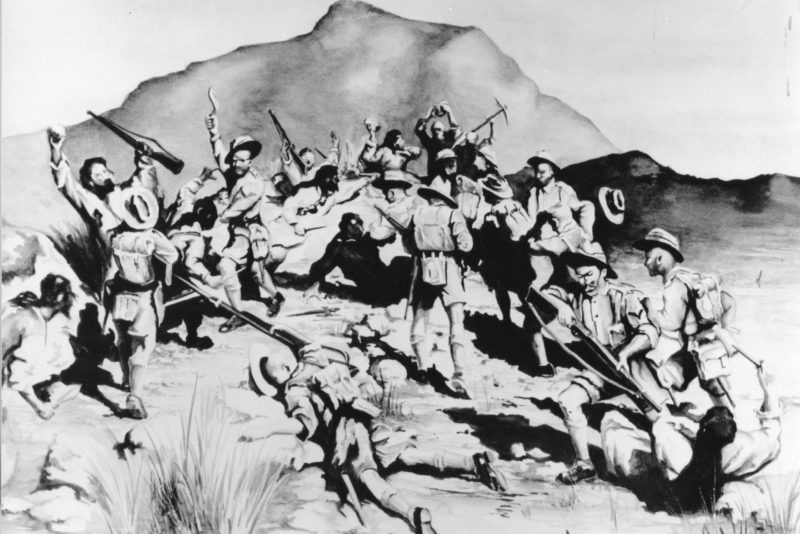Gurkhas at Ahnai Tangi – 14 January 1920

Gurkhas at Ahnai Tangi – 14 January 1920
In the aftermath of the First World War a great deal of unrest occurred on the North-West Frontier between India and Afghanistan. The brief 3rd Anglo-Afghan War occurred in 1919 and much of 1920 and 1921 was spent dealing with the results of this conflict in the region, quelling revolt in large hostile Waziri and Mahsud tribal groups.
The 2nd Battalion of the 5th Gurkha Rifles was deployed to Field Service in Waziristan (a region in the North-West Frontier) in late December 1919, having been rapidly prepared in the preceding days (with Christmas Day being given over almost entirely to the issuing of equipment). In addition, the commanding officer of the Battalion, Lt. Col. J. D. Crowdy, D.S.O returned from leave very unexpectedly on the evening of December 25th, and assumed command in the middle of a full mobilisation, reportedly being very surprised that the Battalion was proceeding on active service the following day.
After a series of delays caused by new mules unused to pack work the Battalion arrived at the site of Palosina Camp on January 3rd 1920, joining up with the 67th Brigade, which contained, amongst other units, the 2nd/9th and 4th/3rd Gurkhas as well. The situation on the ground seemed tainted by low morale and so on January 6th the Brigade moved forward to Kotaki to join up with more reinforcements and then advance on and capture the feature known as Ahnai Tangi gorge, to secure passage into the county beyond and obtain more intelligence about enemy movements there.
After several days of skirmishes the actual gorge was captured and advanced through on January 14th, but overlooking the Tangi river still lay two high ground positions, known as ‘Flathead Left’ and ‘Flathead Right’ which would give any enemy a clear line of sight and fire onto advancing troops. It was determined that these positions had to be taken before any further advance could be made.
On January 14th 1920 the Battalion went into action to secure both Flatheads. Flathead Left was soon captured and Lt.-Col Crowdy moved the Battalion headquarters up to it. As the site was still overlooked by Flathead Right and coming under fire however, ‘A’ Company under Capt. G. A. Maconchy was ordered to secure it. The party moved off and were soon out of sight in a dip between the two features. They did not return, and at this point it is believed that a strong party of enemy soldiers managed to rush Capt. Maconchy’s troops and overwhelm them. A wounded soldier from the party later managed to crawl back to camp at Kotaki that night and report that some of the party had managed to reach the top of Flathead Right, in spite of the opposition, but were faced with a massive outnumbering of troops and were driven back and killed.
With Flathead Right still uncaptured and the troops on Flathead Left under accurate and heavy covering fire, more and more enemy troops began to make their way closer and closer to Lt.-Col. Crowdy’s position, who were also running short of ammunition. To attempt to reverse the situation Lt.-Col. Crowdy led a charge into the attackers, which did manage to drive them back, but in so doing he himself was killed. To make matters worse the retreating enemy troops drove back away from Flathead Left into a supporting force from the Battalion, causing them significant casualties and preventing them from reaching their beleaguered comrades. For the rest of the day the soldiers of 2/5RGR dug in in and around Flathead Left and fought off six attacks from Waziri troops, managing to fight off each one but only after sustaining heavy casualties. By 7.30pm the position on Flathead Left had been reinforced by other troops from 67th Brigade and the Battalion was finally able to withdraw.
Later that evening a funeral service was held, with Lt.-Col. Crowdy buried close to the camp. Capt. Maconchy’s body was also recovered that night, and later buried on the slopes of a nearby hill.
The Battalion had seen some of the fiercest fighting of the Wazristan 1919-1920 campaign, and the casualties sustained against them by the opposing Waziri and Mahsud fighters played a large role in quelling the revolting Mahsud groups later that year, and preventing them from joining further results the year afterwards. To prevent such unrest occurring again a more permanent military presence was established in the region by the British, which would last until 1947.
The medals of Lt. Col. J. D. Crowdy D.S.O, and a memorial plaque created for Capt. G.A. Maconchy by his fellow officers, are both held in the collections of the Gurkha Museum.
Click here to read more about the Gurkhas on the North-West Frontier.

